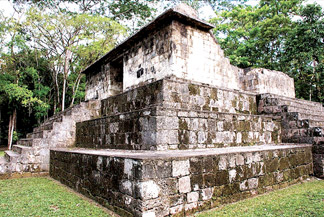Maya roots more tangled than previously thought
|

Ceibal ruins in Guatemala
|
The classic Maya civilisation, which flourished in Central America
for more than 600 years, has been celebrated for its vast city states
adorned with monumental pyramids and for its technological feats such as
the development of an elaborate written language and impressively
accurate astronomical observations.
But for decades, archaeologists have argued over the birth of the
culture that spawned those splendid cities about 1000 BC. Did Maya
society spring from the Olmec civilisation of Mexico's Gulf Coast, known
for its colossal carved stone heads? Or did it emerge independently
through some local process?
A new analysis of items from a long-buried ceremonial structure in
central Guatemala supports a third hypothesis, researchers reported -
that lowland Maya culture grew out of an amalgam of influences from
nearby settlements.
"The origin of Maya civilisation was more complex than previously
thought," said Takeshi Inomata, an archaeologist at the University of
Arizona in Tucson and lead author of a study detailing the analysis in
the journal Science.
In his view, the culture that went on to dominate Mesoamerica until
the arrival of Europeans got its start during a power vacuum that lasted
for about 200 to 350 years in a period of Olmec rule. That allowed the
people who built the ceremonial structure at a site known as Ceibal to
interact with others from nearby areas and begin forming a new culture.
They probably had influences from as far away as Chiapas and the Pacific
Coast, both about 200 miles away.
"Ceibal was a part of this major change," Inomata said.
Inomata has been working at Ceibal, in the southwestern Maya
lowlands, since 2005. The people who lived there repeatedly built on the
same site over hundreds of years, leaving behind layers of civilisation
that extend 30 feet or more beneath the surface. Digging deep to gain
access to ancient construction, Inomata and his team - which included
his wife, Daniela Triadan, also of the University of Arizona -
discovered a collection of structures that archaeologists refer to as
"E-Group assemblages." There was a square building on the west, an open
plaza and a long platform on the east. By 700 BC, the building was as
much as 26 feet tall.
- Los Angeles Times |


